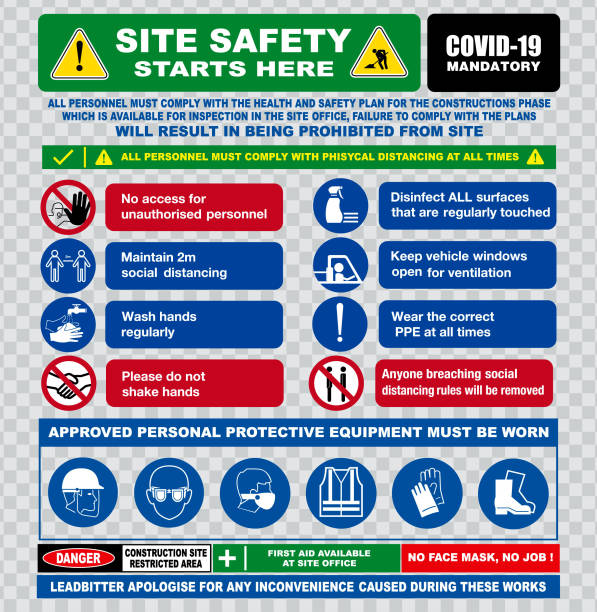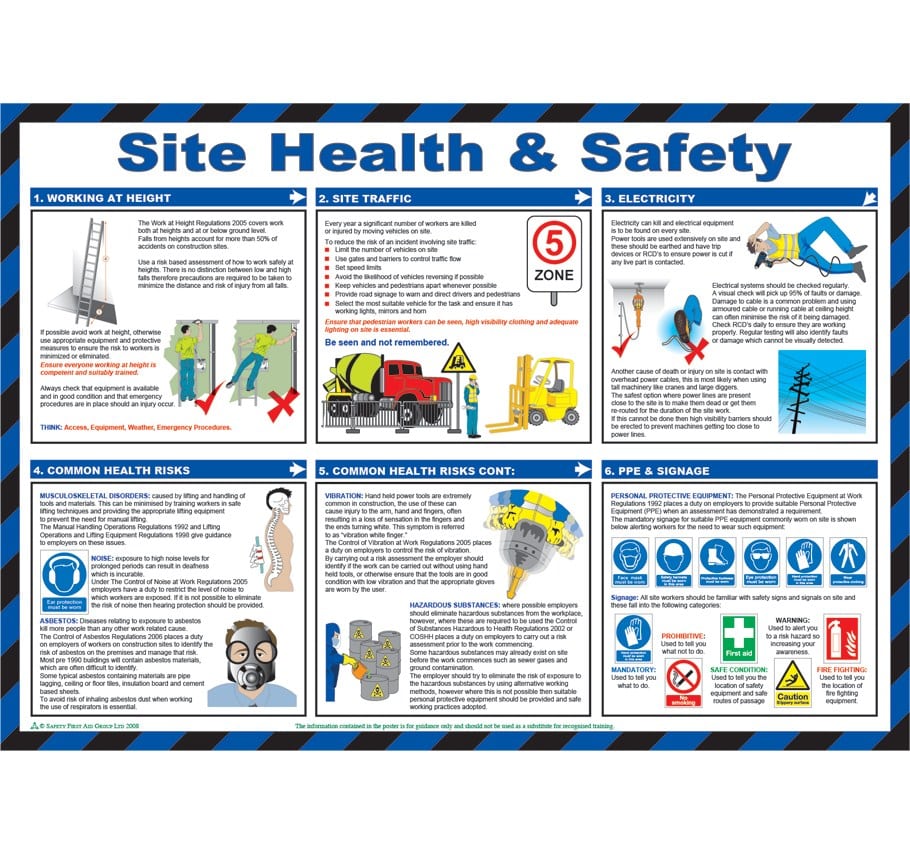
How to Become a Health And Safety in a Construction Environment: Expert Tips
Imagine stepping onto a bustling construction site with confidence, knowing you’re the key to keeping everyone safe. Becoming an expert in health and safety within a construction environment doesn’t just enhance your career; it ensures the wellbeing of countless workers around you.
You might be wondering, “How do I start? ” Or “What skills do I need? ” You’re in the right place. This guide will provide you with the essential steps and insights to master the art of safety in construction, making you indispensable in any project.
Whether you’re just starting out or looking to refine your skills, this article promises to equip you with the tools to create a safer, more efficient workplace. Dive in, and discover how you can make a real difference today.
Qualifications And Education
To excel in health and safety in construction, proper qualifications matter. Formal education and certifications provide the necessary skills and knowledge. Understanding these can set you on the right path. Let’s explore the essential qualifications and education needed.
Relevant Certifications
Certifications validate your expertise in health and safety. The NEBOSH Construction Certificate is widely recognized. It covers health and safety essentials in construction. The Construction Skills Certification Scheme (CSCS) card is also critical. It proves your competence on construction sites. These certifications are vital for credibility and job opportunities.
Necessary Training Courses
Training courses are crucial for hands-on skills. Many focus on specific safety procedures. The CITB Health and Safety Awareness course is popular. It introduces basic health and safety principles. First Aid training is also necessary. It prepares you for emergencies on-site. Regular updates keep your skills sharp and relevant.
Higher Education Options
Higher education offers deeper insights into construction safety. A degree in Occupational Safety and Health is valuable. It provides comprehensive knowledge and problem-solving skills. Some universities offer specialized construction safety programs. These programs blend theory with practical applications. They prepare you for advanced roles in the industry.

Essential Skills
To thrive in the fast-paced world of construction, mastering essential skills is crucial for health and safety professionals. These skills help ensure both personal safety and the well-being of others on site. But what exactly are these skills, and how can they be developed?
Attention To Detail
Every day on a construction site presents a myriad of tasks that require careful scrutiny. Noticing a loose scaffold pin or a frayed wire can be the difference between a safe working environment and potential hazards. Developing a keen eye for detail means being vigilant and proactive. Consider setting aside a few minutes each day to inspect your surroundings, identifying small issues before they escalate. Have you ever missed something critical because you were in a rush?
Communication Proficiency
Effective communication is the backbone of safety in construction. Being able to convey instructions clearly and listen actively ensures everyone is on the same page. Imagine the chaos if safety protocols were misunderstood or ignored. Practicing clear and concise communication can prevent these mishaps. Engage your team in regular safety briefings and encourage open dialogue. How often do you encourage feedback from your peers?
Problem-solving Abilities
Construction sites are dynamic environments where issues can arise unexpectedly. The ability to think on your feet and devise practical solutions is invaluable. Whether it’s rerouting a pathway to avoid hazards or finding a safer method for lifting heavy materials, problem-solving is a daily necessity. Challenge yourself by brainstorming solutions to hypothetical scenarios. What would you do if the main entrance was suddenly blocked?
Embracing these skills empowers you to create a safer, more efficient construction environment. By honing these abilities, you’re not just keeping yourself safe but also safeguarding the entire team. Each skill is a tool in your safety toolkit, ready to be used at a moment’s notice.
Gaining Experience
Gaining experience in health and safety within a construction environment is crucial. It builds your skills and enhances your understanding of industry practices. This experience not only boosts your confidence but also makes you a valuable asset to potential employers. Various avenues exist to gain hands-on experience, each offering unique learning opportunities.
Internships And Apprenticeships
Internships provide real-world exposure. They help you understand safety protocols and procedures. You work alongside seasoned professionals, learning the nuances of the job. Apprenticeships offer structured training. They combine classroom learning with practical experience on-site. Both are stepping stones to building a solid career foundation.
Volunteering Opportunities
Volunteering offers a chance to gain experience in diverse projects. It allows you to explore different roles and responsibilities. You engage with teams, understand workflows, and contribute to safety measures. Volunteer programs often require minimal commitment but provide valuable insights.
Networking In The Industry
Networking opens doors to new opportunities. Connecting with industry professionals can lead to mentorship and advice. Attend construction safety seminars or conferences. Join online forums and groups dedicated to health and safety. Building relationships helps you learn from others’ experiences and develop your skills.
Staying Updated
Staying updated in the construction health and safety field is crucial. It ensures compliance with regulations and keeps workers safe. The industry evolves rapidly, with new technologies and practices emerging. Keeping up with these changes is essential for professionals.
Industry News And Trends
Regularly follow industry news. Subscribe to construction magazines and websites. They provide the latest updates on health and safety regulations. Trends in technology and equipment are also covered. Staying informed helps anticipate changes and improve safety strategies.
Continuing Education
Enroll in courses related to health and safety. Online platforms offer flexible learning options. These courses keep you updated on the latest standards. They also enhance your knowledge and skills. A well-informed professional makes better safety decisions.
Professional Development Workshops
Attend workshops for hands-on experience. They provide practical insights into safety practices. Industry experts lead these sessions. Networking opportunities abound at these events. Sharing experiences with peers enriches your understanding.
Job Search Strategies
Embarking on a career in health and safety within the construction industry can be both rewarding and challenging. Navigating the job search process might seem daunting, but with the right strategies, you can land your dream role. Whether you’re crafting a resume, preparing for interviews, or utilizing online job portals, each step is crucial in positioning yourself as a top candidate. Let’s dive into actionable strategies that will give you an edge in your job search.
Crafting A Strong Resume
Your resume is often your first impression on a potential employer. Make it count. Highlight your relevant experience in construction safety, emphasizing your skills and achievements. Did you successfully implement a safety protocol that reduced incidents on-site? Mention it. Keep your resume clear and concise, focusing on what’s most important.
Use bullet points for easy readability. Tailor your resume for each application, showcasing the qualifications that match the job description. Consider including a brief summary at the top to outline your career goals and what you bring to the table.
Interview Preparation
Preparing for an interview goes beyond knowing your resume. Research the company and understand its safety culture. What challenges are they facing? How can your expertise solve them? Prepare answers to common interview questions, but also be ready for unexpected ones that test your problem-solving skills.
Practice makes perfect. Conduct mock interviews with a friend or mentor to hone your responses. Dress appropriately for the construction environment, and bring copies of your resume and any relevant certifications. Confidence and clarity can set you apart.
Leveraging Online Job Portals
Online job portals are gold mines for finding construction safety roles. Websites like Indeed, LinkedIn, and industry-specific platforms offer numerous job listings. Set up alerts for new opportunities to stay ahead of the competition. Customize your profile to highlight your expertise in health and safety.
Networking online can be just as effective as face-to-face interactions. Engage with industry groups and forums. Share insights and connect with professionals who might refer you to open positions. Are you actively building your online presence? It might be the key to uncovering your next job opportunity.

Career Advancement
Career advancement in the construction health and safety sector is essential. It opens doors to more responsibilities and greater rewards. Understanding how to climb the career ladder can set you apart. It helps build a successful and fulfilling career.
Leadership And Management Skills
Strong leadership skills are vital in health and safety roles. These skills help you guide teams through complex projects. Effective communication and decision-making are key components. They ensure safety standards are met without compromise.
Management skills enhance your ability to oversee safety protocols. They help maintain compliance with regulations. These skills also assist in problem-solving and conflict resolution.
Advanced Certifications
Certifications play a crucial role in career advancement. They demonstrate your expertise and commitment to safety. Obtaining advanced certifications can boost your credibility. It shows your dedication to staying updated with industry standards.
Certifications like OSHA or NEBOSH are highly regarded. They provide deep insights into safety practices. Pursuing these can position you as a leader in your field.
Mentorship And Guidance
Having a mentor can significantly impact your career growth. Mentors provide valuable insights and advice. They share their experiences and help you avoid common pitfalls.
Guidance from seasoned professionals can accelerate your learning. It helps you understand complex safety scenarios. Building strong relationships with mentors can enhance your career trajectory.
Common Challenges
Navigating health and safety in construction involves understanding risks and regulations. Workers often face challenges with compliance and training. Ensuring proper equipment use and hazard recognition are crucial for a safe environment.
Navigating the world of health and safety in a construction environment can be daunting. You face numerous challenges that require your constant attention and action. Understanding these common hurdles is the first step toward ensuring a safer workplace.
Dealing With Compliance Issues
Meeting compliance standards can feel like aiming at a moving target. Regulations change, and staying updated is crucial. You need to be proactive in understanding local, state, and federal safety regulations. Regular training sessions for your team can help bridge knowledge gaps. It’s not just about meeting legal obligations but ensuring everyone’s safety. Have you ever faced a surprise inspection and realized you’re not fully prepared? That’s the kind of stress you want to avoid.
Managing On-site Safety
On-site safety management is not a one-time task—it’s continuous. You must be vigilant, observing safety protocols throughout the day. Checklists can be your best friend here, ensuring no safety measure is overlooked. Sometimes, it’s the simple things that cause the most trouble, like a misplaced tool or a wet floor. Encourage your team to report hazards immediately. What steps do you take to ensure every worker leaves the site just as healthy as they arrived?
Addressing Worker Concerns
Workers on construction sites often have concerns that need addressing. Listening to these concerns can be a game-changer in preventing accidents. Create an environment where workers feel comfortable voicing their safety worries. Consider setting up regular meetings where workers can express their thoughts and suggestions. Have you ever learned something critical by just listening to a worker’s concern? That insight could potentially save a life. Engage with your team and make safety a shared responsibility. Are you ready to tackle these challenges head-on and make your construction environment a safer place?
Tools And Resources
Understanding the right tools and resources is crucial in construction safety. These help ensure both compliance and protection on-site. From safety gear to digital tools, knowing what to use makes a big difference. Below, explore essentials for safety in construction environments.
Safety Equipment Essentials
Proper safety equipment protects workers from potential hazards. Hard hats guard against falling objects. Safety goggles shield eyes from dust and debris. High-visibility vests make workers visible to machinery operators. Steel-toed boots protect feet from heavy materials. Ear protection reduces noise damage. Always choose quality equipment to ensure maximum safety.
Software For Safety Management
Software helps manage safety protocols effectively. It tracks incidents and monitors compliance. Some applications offer real-time updates. This ensures immediate response to any issue. Other tools help with training and documentation. They simplify processes and improve communication. Investing in reliable software saves time and enhances safety management.
Useful Online Platforms
Online platforms provide valuable resources for safety training. Many offer courses on construction safety practices. They cover risk assessment, hazard identification, and emergency response. Forums and communities allow knowledge sharing among professionals. These platforms connect users with expert advice and updates. Accessing these resources helps stay informed and prepared.

Frequently Asked Questions
What Qualifications Are Needed For Health And Safety Roles?
To work in health and safety in construction, you generally need a relevant qualification. This could be a NEBOSH Construction Certificate or a similar credential. These courses cover essential safety practices and regulations. They are crucial for ensuring a safe working environment in construction settings.
How Can I Gain Health And Safety Experience?
Gaining experience starts with entry-level jobs or internships in construction safety roles. Volunteering for safety committees or shadowing professionals helps too. These opportunities allow you to understand real-world safety challenges and solutions. Practical exposure is invaluable for building a solid foundation in this field.
What Skills Are Essential For Health And Safety Officers?
Essential skills include attention to detail, excellent communication, and problem-solving abilities. Understanding safety regulations and risk assessment is crucial. These skills help in identifying hazards and implementing safety measures effectively. Continuous learning and staying updated with regulations are also important for success in this role.
How Long Does Training Typically Take?
Training duration varies based on the course and level pursued. A basic health and safety course may take a few days. Advanced certifications like NEBOSH can take several weeks to months. Comprehensive training ensures thorough understanding and application of safety practices in construction environments.
Conclusion
Becoming a health and safety expert in construction is rewarding. It requires dedication and learning. Start with basic knowledge and build practical skills. Safety saves lives and ensures smooth operations. Remember, small details can prevent big accidents. Stay updated with new safety standards.
Practice makes perfect. Regular training is key. Engage with experienced professionals. They offer valuable insights. Your commitment can make a difference. Encourage a culture of safety. Everyone benefits when safety is a priority. With patience and persistence, you can succeed.
Be the change in your workplace. Prioritize safety every day.





